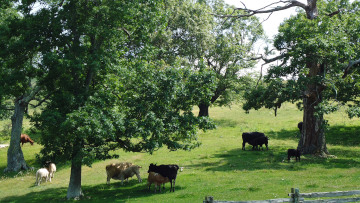To help Canada achieve its objectives under the Paris Climate Agreement (2015), scientists from more than 20 departments, universities and organizations in Canada and USA conducted the first study to evaluate and measure the medium- and long-term effects of adopting 24 Natural Climate Solutions (NCS) in forests, grasslands, agricultural areas, and wetlands. NCS are readily deployable options that can contribute to reduce greenhouse gas (GHG) emission. By capitalizing on the natural carbon storage processes in ecosystems, NCS can already reduce emissions without waiting for new carbon capture technologies. Agriculture and Agri-Food Canada (AAFC) agroforestry scientists focused on NCS which integrate trees and shrubs into farming practices to reduce GHG emissions. Aside from shelterbelts, common in Western Canada, intercropping, silvopasture, and riparian buffer strips have the most potential.
Intercropping entails planting, right in the middle of cultivated fields, rows of high economic value native (or sometimes non-native) trees and shrubs (for example, hybrid poplar, red oak, black walnut, Norway spruce, seabuckthorn, and buffaloberry) that are effective at capturing carbon dioxide (CO2). Of all the agroforestry practices, intercropping would reduce the most GHG emissions; it ranks fourth among the 11 agricultural NCS evaluated in the study. If adopted on nearly 800,000 hectares (ha) of agricultural land in just Quebec and Ontario, this practice would capture around 4 million tons of CO2 equivalent (CO2ₑ) per year. The CO2 "equivalent" includes other GHG converted into CO2, such as methane and nitrous oxide.
Silvopasture involves rearing livestock in treed (tame and seeded) pasture and forested areas where the animals feed on spontaneous undergrowth vegetation. If adopted on an average of 20 ha per livestock farm (totaling 985,000 ha in the 10 provinces), silvopasture would capture 2.8 million tons of CO2ₑ/year.
Riparian buffer strips are areas of perennial vegetation planted along the watercourses of farm fields. They help reduce soil loss, improve water quality, and stabilize the banks. Planting 30 metres of riparian buffer strips along watercourses on farms located in naturally forested areas (200,000 ha in total for nine provinces) would capture 1.62 million tons of CO2ₑ/year.
Prediction models show that transitioning to these three agroforestry practices by 2030 could capture almost 8.5 million tons of CO2ₑ/year. Scientists also calculated the monetary value of these practices when traded on the carbon exchange market. With values ranging from $10 to $50/tonne of CO2 equivalent, the results indicated that agroforestry practices would generate significant additional income for farmers.
By measuring the impacts of adopting agroforestry-related NCS, Canadian scientists are highlighting the full extent of their potential, including other benefits like improved soil fertility, water quality, biodiversity, and maintaining profitability. This study shows that agroforestry practices, combined with other natural climate solutions (in agriculture, wetlands, grasslands, and forests), are part of the solution and will enable Canada to meet and even exceed its Paris Agreement targets.
Learn more about Natural Climate Solutions.



Get more Agri-info
- Want more stories like this? Explore what else Agri-info has to offer.
- Interested in reporting on this story? Contact AAFC Media Relations at aafc.mediarelations-relationsmedias.aac@agr.gc.ca to arrange an interview with one of our experts.